Have you ever gone up into an attic on a hot, summer day? If so, then you know just how hot an attic can get. I have measured attic temperatures as warm as about 165 degrees.

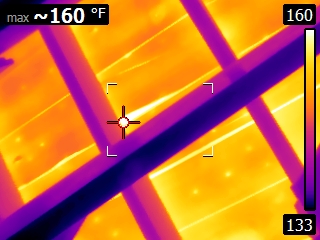
It is unavoidable that some of the heat from your attic will penetrate into the living area of your home and increase your home cooling costs.
The good news is that there are ways to lower the temperature in your attic which will, in turn, decrease the amount of heat entering your home from the attic.
Two of these methods are to improve the ventilation of the attic space, and the other is to install a radiant barrier to block much of the heat that would otherwise enter the attic.
This post will discuss radiant barriers and how they help to lower the temperature in your attic.
What is a Radiant Barrier?
A radiant barrier is a thin, reflective foil that blocks radiant heat by reflecting the heat away from the building or back toward its source. As a result of this, radiant barriers help to increase the energy efficiency of buildings by preventing the majority of the sun’s UV energy from heating up the building.
Studies have shown that when radiant barriers are properly installed, they can reflect 95% – 97% of the sun’s UV energy away from the building. That number shows how effective radiant barriers can be.
Radiant barriers can decrease the temperature in an attic by up to 30 degrees. That is a lot less heat that will be able to find its way into the living space of your home.
It is important to note that blocking 97% of the sun’s UV energy does not mean that your air conditioning needs will also drop by 95% -97%.
There are many sources of heat gain for a house. Some of the ways heat enters a home are the following:
- Warm air entering the home each time a door is opened.
- Warm air entering through small gaps in the exterior siding or bricks, and through gaps at doors and windows.
- Radiant heat warming the brick/siding on the exterior of the home and passing through the wall to the interior of the home.
- Heat passing through windows.
- Heat generated inside the home from cooking equipment, electronics, people, etc.
- Heat from the attic entering the home through the ceiling.
A radiant barrier in the attic will only affect #6 above, but as shown above, it will not completely eliminate it. There are other ways that the attic heats up besides just radiation from the sun hitting the shingles, but a radiant barrier can certainly minimize the largest contributor of heat to the attic.
An Experiment to Show How Radiant Barriers Work
I performed a quick experiment that illustrates how a radiant barrier works.
I turned on a burner on my stovetop and let it heat up for several minutes. (My thermal camera only measures up to 536°, so you can see that the burner was at least 536° F.)
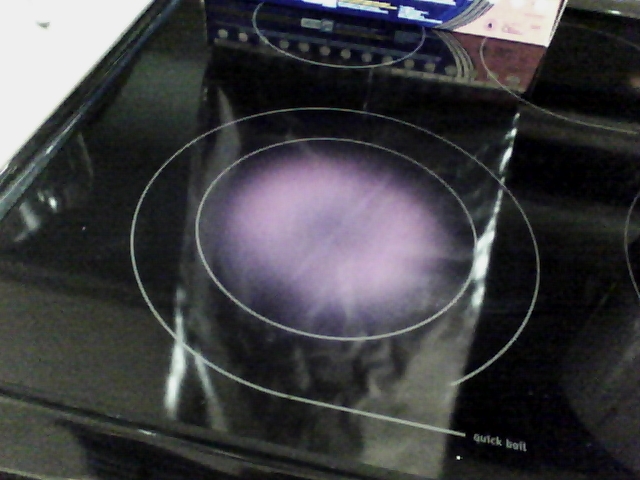
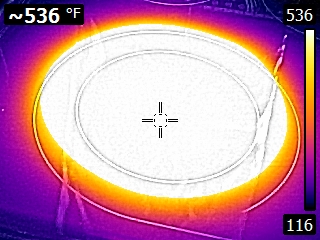
I then elevated a skillet about five inches above the burner. (I elevated it because I only wanted the skillet to heat up by radiated heat and not by conduction.)
I left the skillet above the burner for three minutes and then used my thermal camera to measure the temperature of the skillet.

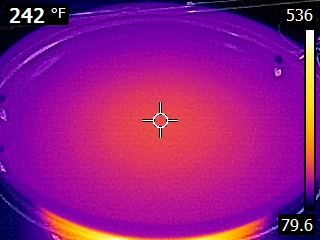
You can see that in three minutes, this skillet heated up to 242°.
Next, I allowed the skillet to cool down.
Leaving the burner on, I then suspended a sheet of aluminum foil between the burner and the skillet.
I waited three minutes to allow the skillet to heat up. (Although it is difficult to see in the photo below, the foil is really suspended and not touching either the burner or the skillet.)

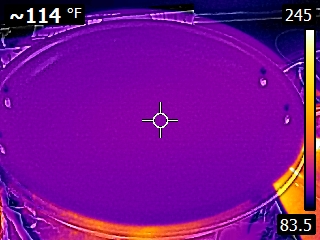
As you can see, after three minutes, the skillet only heated up to 114 degrees – significantly cooler than above where there was no radiant barrier.
This experiment is a simple demonstration to show how incredibly effective radiant barriers can be.
What are the Three Types of Heat Transfer?
Conduction – Conduction occurs when a cooler item comes into contact with a warmer item. The heat flows from the warmer item to the cooler item until a temperature equilibrium is reached. Examples of conduction are the warmth of water transferring to the ice in a glass of water resulting in the cooling of the water. The water transfers some of its heat to the ice because the two are in direct contact with each other. (Convection is involved in the cooling of the water, as well.) Another example is heat transferring from a hot stove top to a pan that is sitting on top of the stove.
Convection – Convection occurs through the movement of a fluid (a liquid or a gas). An example of convection is warm air on a hot summer day coming into home through leaks around doors or windows. Another example is warm or cold air being blown into the home through the air registers by the heat or air conditioning system and that air being distributed through the home by the movement of the air.
Radiation – Radiation is the transfer of heat through space. A great example of this is feeling the warmth of the sun on your face when you walk outside. Even though space is essentially a vacuum, the sun’s energy can move through that empty space and warm you and everything else exposed to the sun.
How Radiation or Radiant Heat Transfer Works
I’m sure you have gotten into a car on a hot summer day and thought it felt like an oven. If it is 100 degrees outside, the temperature inside a car can easily reach 140 to 150 degrees.
How is it possible for it to be hotter in the car than it is outside?
Radiant heat from the sun heats up the windows and body of your car. This heat is then transferred via convection, conduction and radiant heat transfer to the interior of the car. The dashboard, steering wheel, seats etc. all start warming up.
The sun keeps shining and transmitting heat to the car’s interior. As more heat is transferred into the car, the temperature rises further.
The temperature will continue rising until the amount of heat entering the car is equal to the amount of heat leaving the car. (Since the car will eventually be hotter than the outside air, it will start giving off some heat to the outside air.)
The same thing that occurs with the car example above happens in the attic of your home, and as a result, your attic can get very hot.
What is the Main Source of Heat Gain for our Homes?
The main source of heat gain for most homes is through radiant energy from the sun.
The sun heats up the roof via the heat transfer mechanism of radiation. The heat from the roof goes through the roofing materials via the heat transfer mechanism of conduction.
Once the heat goes through the roofing materials to the inside of the attic, it transfers to the air in the attic- also through conduction.
The air in the attic is warmed and moves around, eventually transferring the heat to the attic floor through a mechanism of convection. Some of the heat that reaches the attic floor eventually enters the home and heats up the ceiling which in turn heats up the living space.
As you can see, all three heat transfer mechanisms are involved in heating up our homes during the summer. These same processes cause our homes to lose some heat in the winter months.
Studies have shown that radiant barriers can reduce the amount of heat transferred into the home by 20% – 50%. The amount of savings is determined by the type of radiant barrier used, and how well it is installed.
Radiant barriers are only effective in areas where homes need more cooling than they need heating. They are a waste of money in cooler and cold climates.
In cold climates, radiant barriers will block more useful heat in the winter than they will block unwanted heat in the summer, so they will end up costing you money in the long run instead of saving you money.
What is the Best Type of Barrier?
The simplest radiant barrier to install is a radiant barrier roof decking that is installed as the roof is initially being installed or replaced. A radiant barrier decking is a structural roof decking panel that consists of an OSB panel with heat-reflecting foil laminated to one side.

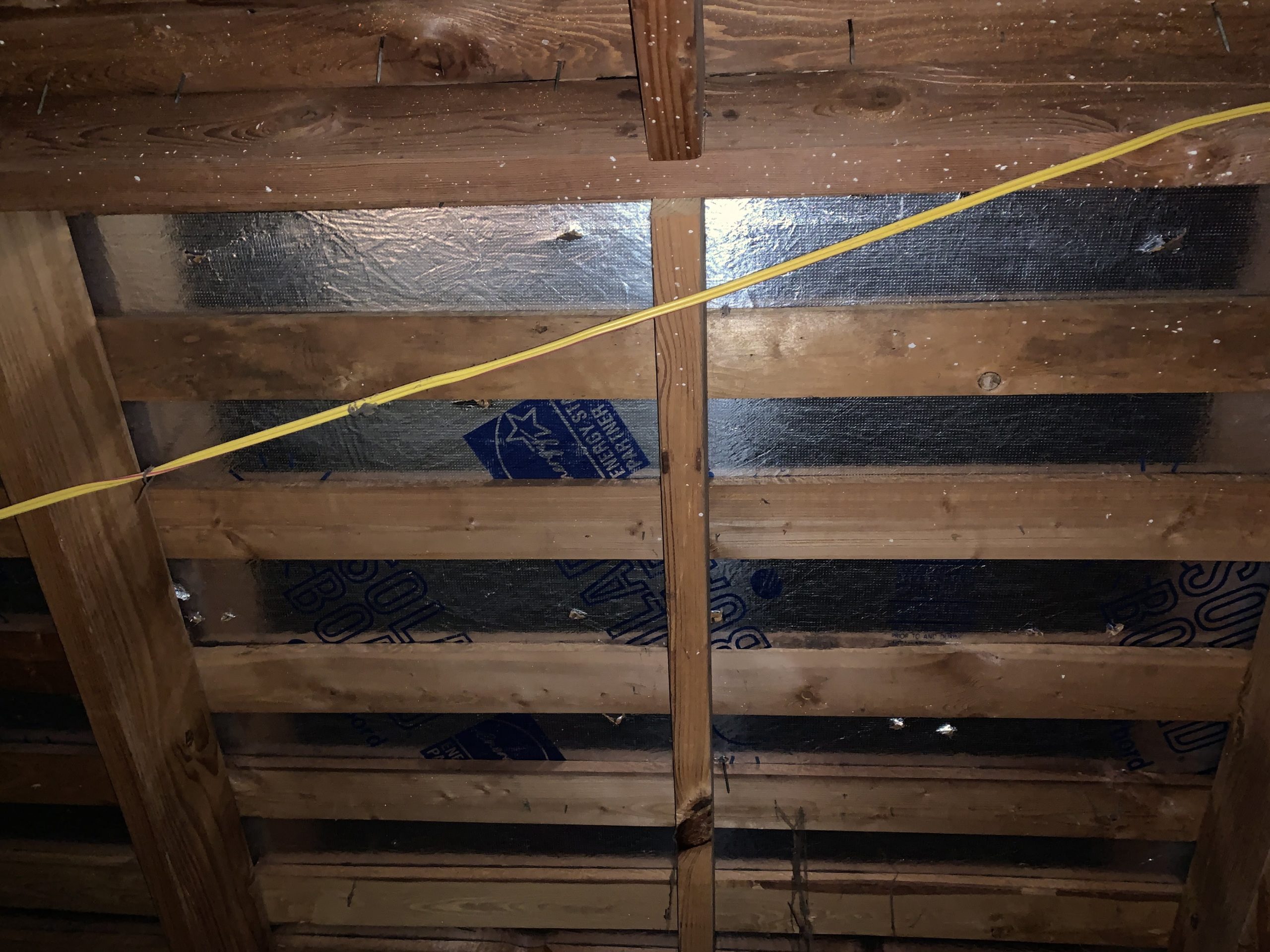
Radiant Barrier Decking
Another type of radiant barrier is a foil fabric that is stapled to the underside of the roof rafters and decking or that is placed directly on top of the attic insulation on the floor of the attic.


Radiant barriers attached to the underside of the rafters.
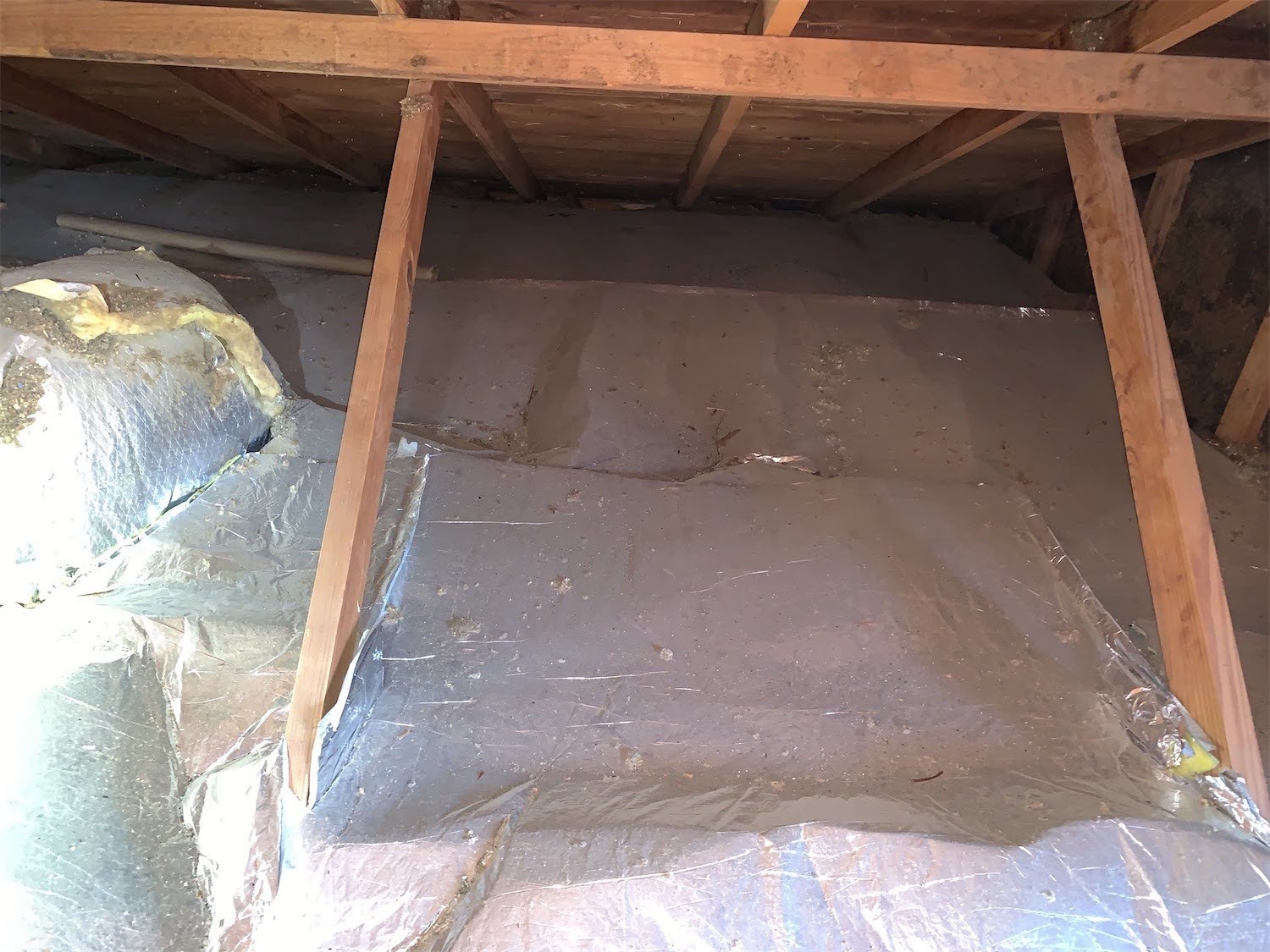
Radiant barrier laid on top of the insulation on the attic floor
NOTE: Installing the radiant barrier foil/fabric on the attic floor on top of attic insulation is not normally a good idea. It can trap moisture in the insulation which can lead to mold problems.
Another problem with installing the radiant barrier on the attic floor is that over the course of time, it will get covered by dust and debris making it less and less reflective and much less effective.
There are some products such as AtticFoil (www.atticfoil.com) that are perforated to allow moisture to go through the fabric and avoid the problem of moisture buildup.
Another type of radiant barrier is a reflective coating that can be painted onto the rafters and roof decking.
A study performed by the US Department of Energy showed that a properly-installed radiant barrier attached to the underside of the roof rafters can decrease the amount of heat entering the home from the attic by 50%. (https://www.solec.org/wp-content/uploads/2018/02/Radiant-Barrier-IRCC-Performance-Report.pdf)
The same study also showed that using a radiant barrier roof decking will decrease the heat entering the attic by about 33%.
The study also showed that painting a reflective coating on the rafters and underside of the roof decking would decrease the heat in the attic by about 19%.
Here is a table that summarizes these three types of radiant barriers.
| Type of Radiant Barrier | Heat Reduction in Attic |
|
Foil on underside of rafters and roof decking |
49.8% |
| Radiant Barrier Roof Decking | 32.8% |
| Liquid applied low-e coating | 19.1% |
In summary, here are some facts about radiant barriers
- They are only beneficial in areas where you spend more days of the year cooling your home than heating your home. In cooler climates they are a waste of money.
- They must be installed with an air space on the reflective side. Without an air space of at least an inch or so, they will simply conduct the heat through to whatever is touching the barrier.
- They can reduce the amount of heat entering the home by as much as 50%.
- To get the most benefit out of a radiant barrier, it must be properly installed. It is best to have the radiant barrier professionally installed, but if you have some handyman skills, it can be a do-it-yourself project.
I hope this post has given you some good information to ponder as you consider installing a radiant barrier in your home. If you have any questions or comments about this post, please comment below.
© 2021 Mike Morgan
This article was written by Mike Morgan, the owner of Morgan Inspection Services. Morgan Inspection Services has been providing home, septic and well inspection services throughout the central Texas area since 2002. He can be reached at 325-998-4663 or at mike@morganinspectionservices.com. No article, or portion thereof, may be reproduced or copied without prior written consent of Mike Morgan.

